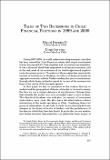Mostrar el registro sencillo del ítem
Tales of two recessions in Chile: financial frictions in 1999 and 2009
| dc.contributor.author | Fuentes D., Miguel | |
| dc.contributor.author | Saravia, Diego | |
| dc.coverage.spatial | CHILE | es_ES |
| dc.date.accessioned | 2019-11-01T00:06:28Z | |
| dc.date.available | 2019-11-01T00:06:28Z | |
| dc.date.issued | 2014 | |
| dc.identifier.isbn | 978-956-7421-43-5 | |
| dc.identifier.uri | https://hdl.handle.net/20.500.12580/3796 | |
| dc.description | During 2007-2009 the world underwent a deep economic crisis that has been termed the Great Recession where total output is estimated to have decreased 0.6%. This event has had two salient characteristics: it was a financial shock that originated in advanced economies and in the end most of the economies of the world experienced negative rates of economic growth. The nature of the recession has renewed the interest of economists in studying the effects of financial shocks on aggregate economic activity. Understanding the precise mechanisms through which financial shocks spread to the rest of the economy has been at the center of the research agenda. | |
| dc.format | ||
| dc.format.extent | Sección o Parte de un Documento | |
| dc.format.medium | p. 137-163 | |
| dc.language.iso | eng | |
| dc.publisher | Banco Central de Chile | |
| dc.relation.ispartof | Series on Central Banking Analysis and Economic Policies no. 18 | |
| dc.rights | Attribution-NonCommercial-NoDerivs 3.0 Chile | * |
| dc.rights.uri | http://creativecommons.org/licenses/by-nc-nd/3.0/cl/ | * |
| dc.subject | CRISIS ECONÓMICA 2008 | es_ES |
| dc.subject | RECESIONES | es_ES |
| dc.title | Tales of two recessions in Chile: financial frictions in 1999 and 2009 | |
| dc.type.doc | Artículo | |
| dc.file.name | BCCh-sbc-v18-p137_163 |


